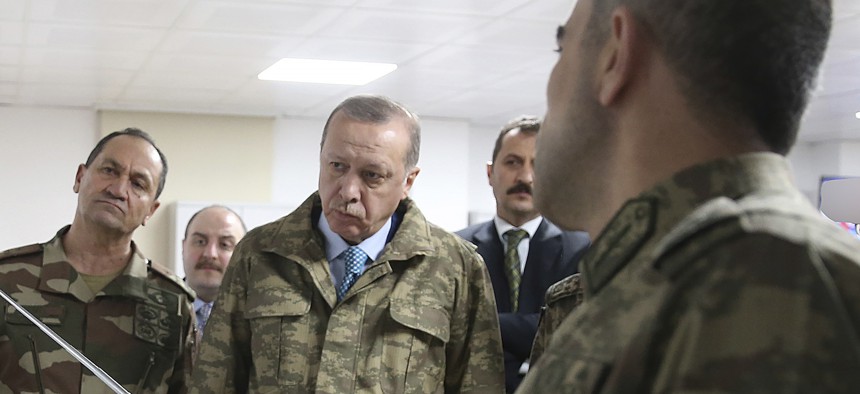
urkey's President Recep Tayyip Erdogan, second left, is briefed by a Turkish Army officer at the command center at the command center in Hatay province, Turkey at the border with Syria, Thursday, Jan. 25, 2018. AP
How Turkey Twisted Three Words Into a Pretext for Invasion
Ankara said a U.S. plan to train some Syrian Kurds was a threat. So it sent tanks and artillery to kill some others.
The Turkish incursion into northern Syria surprised the Trump administration and has begun to hurt U.S. and coalition efforts to fight the remnants of ISIS further south. So how did it come about? Turkey said it was forced to move lest the U.S. execute a plan to train and arm a 30,000-person, partially Kurdish, police force in Syria. But U.S. commanders on the ground and observers of Turkish foreign affairs say that Ankara’s attack was long planned. The so-called Border Security Force was a pretext.
‘Someone Misspoke’
To understand how we got here, with Turkish forces shelling portions of the Kurdish stronghold of Afrin, go back to a December interview that U.S. Army Gen. Joseph Votel, who leads U.S. Central Command, gave to the Associated Press. In the article, Votel describes a program to train members of the local Kurdish and Arab populations in northern Syria, which he calls an essential step to “prevent the resurgence of ISIS” and “help bring control” to the area. Votel is not quoted as saying “border security force” — the author uses the phrase several times.
Skip ahead to January. More reporters are calling about the plan. Around Jan. 14, coalition officials began to circulate details about what had evolved into a more formal entity, a Border Security Force, or BSF. “Currently, there are approximately 230 newly recruited individuals training in the BSF's inaugural class, with the goal of a final force size of approximately 30,000 over the next several years. Efforts are taken to ensure individuals serve in areas close to their homes. Therefore, the ethnic composition of the force will be relative to the areas in which they serve,” reads a copy of an email sent from Operation Inherent Resolve headquarters to The New York Times, and obtained separately by Defense One.
When news reports appeared about this Border Security Force, the Turkish government response was swift and threatening. Turkish president Recep Tayyip Erdogan called it a terror army and promised to “drown” it. Washington immediately tried to smooth over tensions with its NATO ally.
On Jan. 17, Pentagon officials disavowed the term that Operation Inherent Resolve HQ had been using just two days earlier. “This is not a new ‘army’ or conventional ‘Border Force,’” read a Defense Department statement.
That same day, Secretary of State Rex Tillerson told reporters in Vancouver, Canada, that the whole thing was a minor mistake perpetrated by some unknown official. “It’s unfortunate that the entire situation has been misportrayed, misdescribed; some people misspoke,” Tillerson said.
Army Col. Ryan Dillon, a spokesperson at Combined Joint Task Force, or CJTF Operation Inherent Resolve, said his group was partially to blame. “I think that we, at CJTF, Ryan Dillon, did not do a good job of recognizing the semantics of using the ‘Border Guard’ force,” he said. He called the use of the term a “blindspot in the rollout.”
The term “border force,” Dillon conceded, is generally understood to mean an armed group organized to keep people out of a country. But, he explained, the goal of the BSF in Syria was to stop ISIS fighters from fleeing to Turkey or Iraq, not to keep Turkey out.
The term that CJTF settled on did not fully convey that, he said. But if “Border Security Force” lacked precision, the plan to train local Kurds and Arabs in Syria to prevent an ISIS resurgence was neither new nor secret, and especially not to Turkey, he said.
“We’ve been very open and talked about these internal security forces,” said Dillon, “We’ve trumpeted that...This is not new. It was a natural progression to establish these in areas that are unpopulated as well [as populated centers] because of the threat.”
A Convenient Justification
So Ankara has been blaming the BSF for compelling their invasion. But the Turkish assault has focused on Afrin, where the U.S. isn’t training anyone. That points to a disconnect between the stated reason for the strike and the real one. “We have not operated or conducted operations in Afrin at all. But there are those who have conflated the two, and tried to tie them together. They’re completely separate,” said Dillon.
Scholars who watch the Turkish government say it’s using the BSF as an excuse for activity that it was planning to commence anyway. There’s a Russian connection as well.
“Erdogan has been threatening a military incursion into Afrin for a year but it was delayed because Russia did not give Turkey the green light until now,” said Gonul Tol, the director of the Middle East Institute's Center for Turkish Studies. “The border force story prompted the Russian decision to allow the Turks to mount the attack. Russians are very concerned about a prolonged U.S. presence in Syria.”
Charles Lister, a senior fellow at the Middle East Institute, added that the attack was long expected. “After all, Afrin has huge symbolic value for the [Kurdish Democratic Union Party] and [People’s Protection Units, or YPG] cause in Syria, and its untouched presence across from the Turkish border was never going to be left alone forever,” he said.
But, Lister said the BSF might have sped up the assault. “As far as Ankara is concerned, the YPG is an armed militia that operates across all of northern Syria, and thus, any American support to the YPG will directly or indirectly strengthen it elsewhere.” He said this helps explain why Turkey is attacking Afrin, a city where, “the YPG lay more vulnerable, especially given Russian indications that it was considering abandoning the group in exchange for other political interests.”
